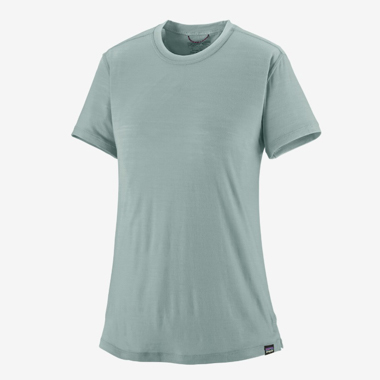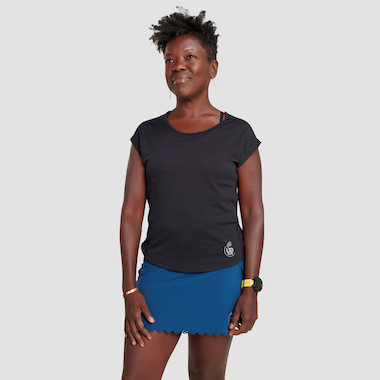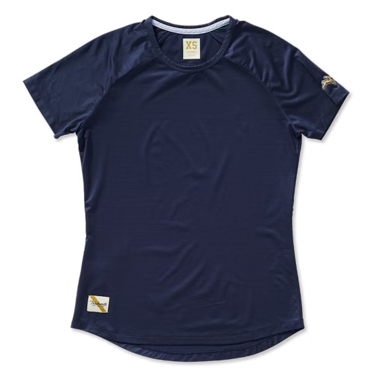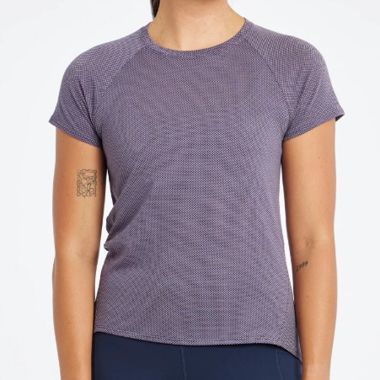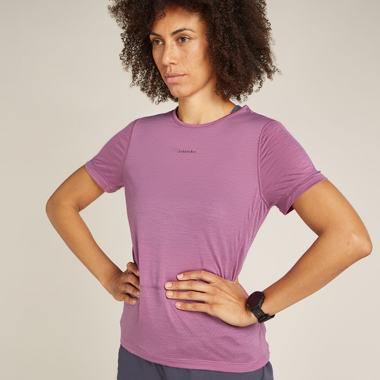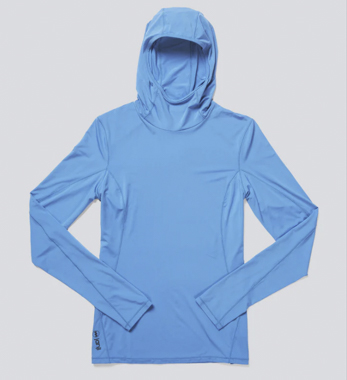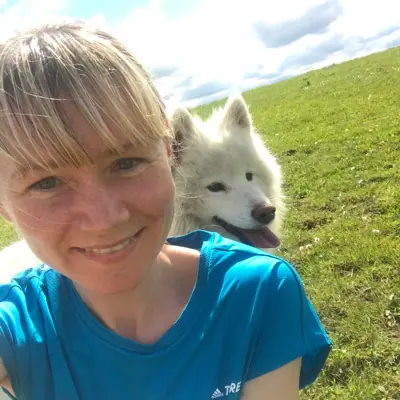
There are countless types of running shirts, each with features that set them apart from the rest. Photo: iRunFar/Eszter Horanyi
After years of testing the full spectrum of running shirts on windy 14ers in Colorado, through the hot, humid bogs of the U.S. East Coast, and everywhere in between, we’ve rounded up the best women’s running shirts for trail running, ultrarunning, and everyday use. The right shirt should fit comfortably, breathe well, wick moisture from your skin so that it can evaporate, not chafe, and be comfortable to wear under both layers and a pack. With seemingly endless options available, it can be hard to comprehend where to start the search for the right running shirt for your needs.
To create this guide, our testers, who have various body types, running goals, styles, and material preferences, took shirts out in all kinds of conditions. We judged them on a variety of factors so that we could recommend the best on the market. We picked the Patagonia Capilene Cool Merino Shirt as our favorite overall shirt and the Ultimate Direction Nimbus Tee as a close second.
If you’re looking for a shirt that will protect you from the sun, take a look at our best sun shirts for running guide. Or, if you’re searching for a tank top, you can explore options in our best running tank tops for women guide.
For even more resources, check out our buying advice for running shirts for women, our testing and reviewing methodology, and our answers to frequently asked questions about women’s running shirts.
And if you’re looking for men’s running shirts, see our guide to the best running shirts for men.
Best Running Shirts for Women
- Best Overall Running Shirt for Women: Patagonia Capilene Cool Merino Shirt
- Best Overall Running Shirt for Women — Runner-Up: Ultimate Direction Nimbus Tee
- Best Hot-Weather Running Shirt for Women: Tracksmith Twilight Tee
- Best Hot-Weather Running Shirt for Women — Runners-Up: rabbit EZ Tee Perf SS, Oiselle Flyout Short Sleeve
- Best Wool Running Shirt for Women: Icebreaker Merino Blend 125 ZoneKnit Energy Wind Short Sleeve T-Shirt
- Best Long-Sleeve Running Shirt for Women: Janji Sunchaser 50 Hooded Long Sleeve

We evaluated women’s running shirts on their fit, breathability, durability, wicking ability, and more. Photo: iRunFar/Eszter Horanyi
Best Overall Running Shirt for Women: Patagonia Capilene Cool Merino Shirt ($69)
- Very soft
- Light and breathable
- Dries quickly
Cons:
- Seams on the shoulders
- It will shrink if you accidentally dry it
Soft, breathable, and quick-drying, the Patagonia Capilene Cool Merino Shirt is our favorite all-around running shirt. The merino and polyester jersey knit fabric feels oh-so-soft on the skin. It’s a running shirt that moves with you on the trail and is an excellent option for anything from weekday easy runs to a 100-mile race. The shirt uses Responsible Wool Standard-certified wool, is Bluesign approved, and is made in a Fair Trade Certified factory. We’ve always appreciated Patagonia’s commitment to environmental sustainability, and this shirt is no exception.
Hands down, this high-performance women’s running shirt is the one we repeatedly reached for during our testing for this guide, using it for hundreds of miles of running among our testers. It’s a shirt you can wear multiple times between washes without it getting smelly, and then you’ll want to put it back on again after it’s clean — just be careful to hang dry when you wash it. One tester accidentally put it in the dryer, and it shrank a little bit, though not enough to make it unwearable.
The Patagonia Capilene Cool Merino Shirt fits comfortably — neither too tight nor too loose. The sleeves are long enough to cover your shoulders and upper arms, and gussets under the sleeves give you a full range of motion without any tugging. Flatlock seams across the shoulders may be irritating with a hydration vest, though our testers didn’t have any issues with chafing. Finally, while Patagonia made this shirt for running, it can also work for other activities or casual everyday wear.
This shirt is so light it’s possible to forget you’re even wearing it. It’s quick-drying, but if you want to get it wet to cool off, it does a fine job of letting cold water pull heat from your body. After multiple sweaty sessions without washing, we can attest that it passes the stink test.
Material: 65% Responsible Wool Standard-certified merino wool, 35% recycled polyester| Seams: Flatlock | Actual weight: 2.6 ounces (74 grams)
Shop the Patagonia Capilene Cool Merino ShirtBest Overall Running Shirt for Women – Runner-Up: Ultimate Direction Nimbus Tee ($70)
- Breathable and quick-drying
- Excellent at moderating temperature
Cons:
- Short sleeves and a wide scoop neck provide less sun protection and more chafing potential
- Dark colorways aren’t ideal for very hot days
Cool and wicking in warm weather and warm and insulating on cool days, the Ultimate Direction Nimbus Tee exemplifies how high-tech materials can elevate a humble piece of apparel. This tee looks and feels nothing like any other shirt we’ve seen, and it excels in all the ways we want a running shirt to function.
The Polartec Delta technology in the fabric makes it exceptional at wicking, cooling, and keeping odor at bay. While traditional wicking treatments wash off over time, Polartec Delta is a non-chemical wicking and cooling solution. A specialized knit weave of hydrophobic and hydrophilic yarns in a radiating structure expertly disperses sweat so that it can evaporate efficiently and cool your body effectively.
Rather than feeling over-engineered, the Ultimate Direction Nimbus Tee is highly breathable, light, and quite thermoregulating. As one tester noted, “It’s so nice. Breathable and wicking on hot days. Warm on cool days.” Our only wish is that this shirt would be available in more light-colored options. The black shirt we tested was not an option for 100-degree days in July.
Flatlock seams in a raglan sleeve pattern help prevent chafing if you’re wearing a hydration pack, as the seams don’t sit directly on the top of the shoulders. To further help with odor control, the fabric has a Polygiene antimicrobial treatment, and we could wear this shirt multiple times before it picked up a smell.
Not everyone is going to like the fit of this shirt. The wide neck opening and relatively short cut on the sleeves may not provide as much sun or chafing protection as you want, and we found that this shirt fits a bit short, especially for a runner with a longer torso.
Material: 52% polyester, 44% Lyocell, and 4% spandex | Seams: Flatlock | Actual weight: 3.1 ounces (88 grams)
Shop the Ultimate Direction Nimbus TeeBest Hot-Weather Running Shirt for Women: Tracksmith Twilight Tee ($70)
- Soft and silky smooth
- Breathable and dries quickly
Cons:
- Runs small
The Tracksmith Twilight Tee is lightweight and airy, and its silky-smooth mesh feels soft and cool against the skin. This shirt is luxurious and made from an Italian micro-polyester and elastane blend called Bravio. Of all the shirts tested, it is the softest while still being highly breathable and quick-drying. A bonus is that this perforated fabric is naturally antimicrobial and doesn’t smell after multiple sessions between washes. The high-gauge knit contains small pointelle holes that maximize airflow, help the shirt dry very quickly, and give it plenty of stretch.
We love the cut and drape of this sporty tee. Tracksmith apparel runs notoriously small, and this shirt is no exception, so consider sizing up if you want a loose, flowy fit. Raglan sleeves keep the flatlock seams away from your shoulders to minimize the opportunity for chafing when wearing a pack.
One of our gear testers wore this shirt for almost 24 hours straight at the Western States 100, consistently drenching it in creeks through the hottest part of the day and then for another 30 hours through intense temperature swings at the IMTUF 100 miler. It indeed passed the test among our squad of ultrarunners!
Material: 85% polyester and 15% elastane | Seams: Flatlock | Actual weight: 3.1 ounces (88 grams)
Shop the Tracksmith Twilight Tee
Best Hot-Weather Running Shirt for Women — Runner-Up: rabbit EZ Tee Perf SS ($48)
- Soft and stretchy
- Breathable and quick-drying
- Good value
Cons:
- Not as odor-resistant as other top picks
- Thin mesh fabric is susceptible to snags
We consistently reach for the rabbit EZ Tee Perf SS for the hottest summer runs. This running shirt includes soft, perforated mesh that feels stretchy, light, and airy. It has a flattering tailored fit that drapes nicely and doesn’t cling, though it’s not quite as loose and flowy as the Tracksmith Twilight Tee or Patagonia Capilene Cool Merino Shirt above.
The shirt’s raglan sleeves provide some sun protection while allowing freedom of movement. The seams are off the shoulder, and we never had any issues with chafing, even if we were wearing a pack. We found that the rounded scoop neck is the right size for comfort while still providing some protection from the sun’s rays or from the straps of your hydration vest.
This shirt quickly became our go-to for sunny midday runs during the summer heat. It feels light as a feather against the skin and breathes as well as any shirt can. One of our testers wore it for a 30-plus-mile run on the Loowit Trail in Washington during August and dunked it in fresh alpine streams during the heat of the day. She noted that the shirt held water long enough to cool her down, yet it never lost its shape or felt heavy and dried in a flash.
Happy with its performance, the same tester wore this shirt for a summer adventure-run bender that included Oregon’s 40-mile Timberline Trail, Washington’s 20-mile Enchantments Traverse, and Nevada’s 35-mile Ruby Crest Trail.
Although we worried about the thin mesh on this shirt snagging, we have yet to experience any durability issues. One thing worth noting, however, is that this shirt’s polyester fabric isn’t as stink-resistant as some of our other favorite shirts. Although it requires regular washes between runs, we reach for it as soon as it’s dry again. Finally, while we’d stop short of calling this shirt inexpensive, it’s a great value — and by far the least pricey shirt in this guide.
Material: 94% polyester and 6% spandex | Seams: Flatlock | Actual weight: 2.7 ounces (76 grams)
Shop the rabbit EZ Tee Perf SSBest Hot-Weather Running Shirt for Women — Runner-Up: Oiselle Flyout Short Sleeve ($62)
- Breathable and dries quickly
- Comfortable, flattering fit
Cons:
- Soft mesh fabric can snag
- Lighter colorways are slightly see-through
Like our other favorite running shirts, the Oiselle Flyout Short Sleeve is amazingly versatile. It’s airy, light, and breathable during hot-weather runs and perfectly comfortable on cooler days. Its tailored yet flowy fit doesn’t cling or restrict, yet it layers well underneath a long-sleeve shirt, jacket, or hydration vest.
Depending on the style you’re going for, you can tuck it into your shorts or leave it hanging loose. An earlier version of this shirt ran a bit short, especially for runners with longer torsos. However, Oiselle has updated the silhouette with a longer design and a slightly shorter hem in the front and longer in the back, which is both comfortable and flattering. Finally, its crew neck and raglan sleeves provide good sun coverage and comfort under a hydration vest.
Oiselle’s Flyout Hoverfit fabric is a blend of recycled polyester, Lyocell, and Lycra that truly feels like it’s hovering on the surface of your skin. We love this shirt for speed workouts when working up a sweat, no matter the air temperature. The design provides comfort and moisture-wicking performance, and our testers found that this extremely lightweight mesh material did a great job keeping their skin dry.
Although this shirt has withstood the test of time without giving us any durability concerns, the thin mesh fabric can snag if you’re not careful. Otherwise, this is a shirt we’ve been wearing for years and will continue for many seasons.
Material: Flyout Hoverfit (49% polyester, 49% Lyocell, 2% spandex) | Seams: Plain | Actual weight: 2.5 ounces (71 grams)
Shop the Oiselle Flyout Short SleeveBest Wool Running Shirt for Women: Icebreaker Merino Blend 125 ZoneKnit Energy Wind Short Sleeve T-Shirt ($90)
- Lightweight
- Odor-resistant
Cons:
- The thin material is prone to snagging
- Less durable than synthetic shirts
Wool is an outstanding material for running clothing, and the IcebreakerMerino Blend 125 ZoneKnit Energy Wind Short Sleeve T-Shirt is a lightweight shirt ideal for wearing in a variety of temperatures. The wool lovers on our testing team were impressed with just how lightweight this shirt is. Made of a blend of 60% Tencel lyocell and 40% merino wool, it has all of the beneficial properties of wool with the added durability and stretch of synthetic fabrics.
This shirt has mesh panels under the arms and around the waist to improve breathability. The shirt fits a little small, but the material has plenty of stretch. If you like a looser-fitting shirt, you might want to size up if you’re between sizes.
We appreciated how odor-resistant this shirt was. During testing, we took it out multiple times between washes, and it took a long time before we could detect any odor. The antimicrobial properties of wool make this an ideal shirt to take with you on a road trip or while traveling when you might not have regular access to laundry.
Wool has the added benefit of not losing its insulating properties when damp, so this is an excellent short-sleeve baselayer to wear under long sleeves on chilly runs. We never felt damp or clammy in this shirt, even after running in the heat or sweating through it when overdressed in the cold.
We were impressed with this shirt’s durability, as we had misgivings about whether the fabric would hold up when we first started wearing it. While wool isn’t as durable as synthetic fabrics, this shirt has held up to more than a year of regular use and laundering and shows no obvious signs of wear. While it feels prone to snags, we haven’t put any holes in it, even after many miles of off-trail use in the mountains of Colorado and the canyons of Utah.
We also featured this shirt in our best wool running apparel guide, where you can learn more about what makes wool such an excellent material for running clothing.
Material: 60% Tencel lyocell, 40% merino wool | Seams: Flatlock | Weight: 3.4 ounces (97 grams)
Best Long-Sleeve Running Shirt for Women: Janji Sunchaser 50 Hooded Long Sleeve ($78)
Pros:
- Lightweight
- Protective hood
- Long sleeves
Cons:
- Not odor-resistant
With the increased awareness of the need for sun protection, sun shirts have become increasingly popular, and the Janji Sunchaser 50 Hooded Long Sleeve is our favorite. It has a UPF 50 rating, meaning it only allows 2% of the sun’s rays through. This is essentially the industry standard for highly sun-protective clothing. The lightweight material makes this long-sleeve shirt stand out from the rest, and we were happy to name it our overall favorite in our Best Sun Shirts for Running guide. The polyester and Spandex blend is light and airy, and we could wear this shirt in hot conditions.
Janji is a brand that seems to nail the cut and fit of most of the running apparel it creates, and this shirt is no exception. The sleeves are long with good thumbholes that can keep the sleeves down over the back of your hands. We found the hood to be plenty deep to wear over a hat and ponytail, and it comes up high enough under the chin to provide the front of the neck with sun protection as well.
This shirt has a loose fit, which we appreciate for its breathability on hot days. It also allows for a full range of motion. The off-shoulder seams reduce the chance of pack straps chafing.
Janji has earned a reputation for being an environmentally friendly company. The company donates 2% of its profits to clean water projects worldwide and uses recycled materials for many products, including this shirt. We’ve worn this shirt in all sorts of conditions, including under heavy packs and in the bright sun for long periods, and we haven’t noticed any fading or signs of excessive wear.
Our only gripe is that this shirt does pick up a smell fairly quickly.
Materials: 84% recycled polyester, 14% Spandex | Seams: Regular | Weight: 6.0 ounces (170 grams)
Shop the Janji Sunchaser 50 Hooded Long Sleeve| SHIRT | PRICE | MATERIALS | WEIGHT |
| Patagonia Capilene Cool Merino Shirt | $69 | Merino wool, polyester | 2.6 ounces |
| Ultimate Direction Nimbus Tee | $70 | Polyester, Lyocell, spandex | 3.1 ounces |
| Tracksmith Twilight Tee | $70 | Polyester, elastane | 3.1 ounces |
| rabbit EZ Tee Perf SS | $48 | Polyester, spandex | 2.7 ounces |
| Oiselle Flyout Short Sleeve | $62 | Polyester, Lyocell, spandex | 2.5 ounces |
| Icebreaker Merino Blend 125 ZoneKnit Energy Wind Short Sleeve T-Shirt | $90 | Lyocell, merino wool | 3.4 ounces |
| Janji Sunchaser 50 Hooded Long Sleeve | $78 | Recycled polyester, spandex | 6.0 ounces |

The rabbit EZ Tee Perf SS (front) and Tracksmith Twilight Tee (back) were two of our favorite running shirts. Photo: iRunFar/Eszter Horanyi
Buying Advice: How to Choose Running Shirts for Women
Finding the best running shirts for women is admittedly a lot easier — and with lower stakes — than finding a lot of other running-related gear, such as shoes. But the options are endless, with vastly different performance, cost, and functionality that can easily lead to choice paralysis.
As with most other gear choices, there is no one shirt for every runner on every type of run. Some of us like synthetic materials, like those found in the rabbit EZ Tee Perf SS, others prefer wool, like in the Icebreaker Merino Blend 125 ZoneKnit Energy Wind Short Sleeve T-Shirt, and some choose long-sleeve options over short sleeves for sun protection.
Use this guide to get a sense of some of the best options and learn about the subtle differences and features among shirts. We’re here to help steer you in the right direction and help you hone your choices. To do so, there are some characteristics to which you should pay attention.
Use
When selecting a running shirt, ask yourself what you will use it for. Do you want a shirt for long days in the mountains or something to keep you warm for a five-minute warm-up before you ditch a shirt entirely during a speed workout? Will you wear it during a hot, muggy summer or as a base layer during the winter? Do you need a shirt you can wear for days without washing? Do you need it to protect you from the sun? Some shirts, like the wool-blend Patagonia Capilene Cool Merino Shirt, can excel across various conditions, which is why we named it our best running shirt for women.
Style
There’s the common adage: Look good, feel good. The rationale behind this motto extends beyond pure vanity, and we know it’s important that your gear reflects your individual style. Some people may find a form-fitting hourglass shirt looks and feels more comfortable than a boxy one, and vice versa. The same goes with capped or boxy sleeves, a crew neck or scoop neck, and a short or long hemline.
We loved the style of the Ultimate Direction Nimbus Tee. We also appreciated the hem of the Oiselle Flyout Short Sleeve, which is longer in the back than in the front. Some shirts, like the Tracksmith Twilight Tee, run a bit small, so you’ll want to size up if you want a looser fit.

iRunFar’s Alli Miles runs in the Ultimate Direction Nimbus Tee on the California coast. Photo: iRunFar/Eszter Horanyi
Comfort
As with any garment, comfort is probably the biggest thing to consider when choosing between some of the best running shirts for women. Our team loved the light and airy feel of the Ultimate Direction Nimbus Tee and the Oiselle Flyout Short Sleeve during hot runs and appreciated that these shirts worked well in cooler weather.
Comfort largely comes down to three elements for a tee: fabric, fit, and seams. Of the options above, the Patagonia Capilene Cool Merino Shirt is buttery soft, while the Tracksmith Twilight Tee is silky smooth, and we loved the feel of each of these shirts for different reasons. Stretch also comes into play since stretchy fabrics tend to move with you.
If you plan on running with a hydration vest, consider how the shirt feels with a loaded pack on your shoulders as well. Does the material rub against your back, slip under the pack’s shoulder straps, or ride up your torso? Notably, none of the shirts in this guide did any of those things during testing.
Fabric
The material and weave of a shirt influence comfort and performance. Most high-performance tees feature polyester blended with spandex. Polyester, a synthetic fabric, tends to feel smooth and doesn’t absorb water. It’s durable and retains its shape. Adding in spandex helps make polyester-based fabrics stretchy and soft. The Polartec Delta fabric used in the Ultimate Direction Nimbus Tee can effectively move moisture from the skin for improved wicking and is surprisingly odor-resistant.
Some running shirts, like the Patagonia Capilene Cool Merino Shirt and the Icebreaker Merino Blend 125 ZoneKnit Energy Wind Short Sleeve T-Shirt, feature merino wool blends. Merino wool is often less durable than synthetic fabrics but is an excellent option if odor control over multiple uses is important to you. A good merino-blend wool shirt will repel odor and have excellent insulating capabilities, and the synthetic material in the blend will enhance durability.
Seams
Shirts are composed of multiple pieces of fabric stitched together at seams. When you make the same motion over and over for hours on end, as we do when we run, even the slightest irregularity in a fabric, such as a seam, can cause serious irritation over time. This means that both seam design and placement play a role in keeping you comfortable and chafe-free on the trails.
Most running shirts incorporate flatlock seams, where two pieces of fabric are sewn together flat and without overlap. Some manufacturers ditch stitching entirely, opting for taped seams. Flatlock and taped seams tend to rub against your skin far less than overlock seams. However, taped seams are also more delicate. In addition to seam type, the style of stitching and the thread used can also affect comfort.

Good seams will minimize the chance of chafing when running with a pack. Photo: iRunFar/Eszter Horanyi
How a running shirt fits can also affect how seams interact with your skin. Monica Broder, owner and lead designer at Weft Design Studio, says, “If we’re talking tight-fitting garments, flatlock seams or bonded seams are best. Both allow the fabric to lie very flat, reducing the potential for chafing. If you’re more into looser fitting apparel, it doesn’t need to be as much of a consideration.”
Finally, seam placement also matters. Many running shirts move seams off the top of the shoulder by using raglan sleeves or paneling. These styles introduce more seams, but they eliminate the possibility of a shoulder-top seam rubbing your skin underneath a hydration pack and causing chafing of the shoulder tops.
If you’re unsure how seams affect you, we recommend choosing a running shirt with flatlock seams, like the Patagonia Capilene Cool Merino Shirt or the Tracksmith Twilight Tee.
Breathability
Breathability and drying speed set the best women’s running shirts apart from the rest. Breathability tells you how well the shirt moves sweat away from your skin, allowing it to evaporate rather than soaking the shirt or leaving sweat on your skin. The best running shirts for women include mesh and lightweight materials to optimize their breathability in hot weather. Usually, these materials are a blend of synthetic and/or natural fibers.
We asked designer Monica Broder of Weft Design Studio about the differences between synthetic and natural fiber fabrics when it comes to breathability.
She explains, “Synthetics are great for breathability and durability, and more and more are entering circular design models (recyclable), which is awesome. But, depending on the compound, polyester and nylon can get really stinky. I’m actually a big fan of Merino for most activities. Despite being thought of as an insulating layer, it is a great option for both summer and winter. It’s naturally temperature regulating, breathable, and anti-bacterial, so it can often be worn multiple times between washes.”
Our team found that the rabbit EZ Tee Perf SS and Oiselle Flyout Short Sleeve were incredibly breathable, and the Patagonia Capilene Cool Merino Shirt did a great job resisting odor build-up. We could wear the Icebreaker Merino Blend 125 ZoneKnit Energy Wind Short Sleeve T-Shirt on multiday fastpacking trips without it picking up a smell.

The two different types of fabric of the Icebreaker Merino Blend 125 ZoneKnit Energy Wind Short Sleeve T-Shirt help it with breathability. Photo: iRunFar/Eszter Horanyi
Drying Speed
A shirt’s drying speed comes down to its wicking and water-retention properties. Wicking is how well the fabric pulls moisture from the shirt’s interior to the outside, where it can evaporate. Merino wool and some other materials are naturally good at wicking, while other fabrics gain wicking power from the weave of the fibers or differences between the interior and exterior of the fabric. Many materials are treated with chemical compounds to increase their ability to move moisture. This treatment can become less effective the more you use and wash a shirt.
Garments with a fast drying speed keep you cool on hot days and also help keep you warm on cold days by keeping your skin dry. We found the Ultimate Direction Nimbus Tee incredibly breathable, light, and quick-drying. The Tracksmith Twilight Tee and rabbit EZ Tee Perf SS also dry very quickly. Materials that absorb a lot of water, like cotton, will take longer to dry.

The super-breathable and quick-drying rabbit EZ Tee Perf SS (front) was a great shirt for the Loowit Trail in August. Photo: Alli Miles
Odor Reduction
Sweat is an excellent breeding ground for bacteria, leading to that well-known and universally hated odor that most running clothes pick up after use. Natural fibers, such as wool, counteract bacteria build-up with their natural antimicrobial properties. Other materials receive an odor-control treatment or have odor-reducing elements woven into the fabric. Wool tends to be the best fabric for preventing stink, but many treatments work well, too.
“Natural fibers, as a rule, are typically more odor resistant,” explains Monica Broder of Weft Design Studio. “There are also different coatings that can be applied (Microban, Polygiene, etc.) to fibers to add antimicrobial properties, but if you just start with a material that is naturally odor resistant, you don’t need all that fancy stuff!”
If odor is a concern, try the wool-blend Patagonia Capilene Cool Merino Shirt or Icebreaker Merino Blend 125 ZoneKnit Energy Wind Short Sleeve T-Shirt.
Ultraviolet Protection Factor Rating
You can think of ultraviolet protection factor (UPF) ratings for apparel, such as sunscreen ratings for our skin. According to the Skin Cancer Foundation, a UPF rating of 50 for a material means that only about 1/50th (or 2%) of the sunlight that hits the material goes through and reaches your skin.
All shirts provide some sun protection, with most clothing having about an eight to 15 UPF rating. Fabrics with certain dyes or weaves can have additional UPF protection; darker colors provide more protection than light ones. Manufacturers are only allowed to advertise the UPF rating if it exceeds 15.
For maximum sun protection, opt for a sunshirt. Many sun shirts, like the Janji Sunchaser 50 Hooded Long Sleeve, include a hood to protect the neck and top of the head, and some have cuffs to partially cover the hands. See our best sun shirts for running guide to learn more.

Sun shirts can protect you from harmful UV rays without causing you to overheat. Photo: iRunFar/Eszter Horanyi
Extra Features
While the shirts in this guide are all fairly simple, some other options have features that set them apart from the rest. Elements like a half-zip, collar, and reflective detail differentiate short-sleeved tees. A half-zip and a collar can provide ventilation and chafing protection if you wear a pack.
Reflective elements add visibility when running on the streets at night. Ultimately, your choice of shirt boils down to personal preference, especially since something like a zipper or a collar will add a little bit of weight.
The environmental impact of clothing is increasing in importance for many. Several shirts in this guide are made of recycled materials to reduce their impact. If you’re looking for clothing made in an eco-friendly manner, consider the responsibly sourced wool and recycled materials of the Patagonia Capilene Cool Merino Shirt.
Why You Should Trust Us
We began this guide by researching shirts from the most trusted brands in running, premier outdoor brands, and major companies in the women’s run category. Next, we polled the large iRunFar team and trusted running friends to find out which women’s running shirts they love and which they don’t care for as much. We narrowed our search to 20-plus shirts that we tested in the field.
When we first created this guide, two iRunFar testers spent four months subjecting these running shirts for women to the rigors of mountainous Colorado and hot, humid New Hampshire summers. They ran in them for 50-mile outings, 50k races, and multiday backpacking trips, and they wore them several times in a row without washing them (yuck, but you’re welcome).
Since then, we’ve continued to test the original shirts in the guide to assess their long-term durability and added new ones to our testing pool. We wear the shirts in as many weather and running conditions as possible to provide the most accurate assessments. We rate shirts on comfort, fit, breathability, moisture-wicking ability, and drying time, and we aim to get as many different opinions on various shirts as possible.
Frequently Asked Questions About Running Shirts for Women
Can I run in a cotton tee?
Absolutely. “You can run in whatever you’re comfortable in,” says Monica Broder, owner and lead designer at Weft Design Studio. “For shorter runs around town, I’ll often just throw on a cotton T-shirt and shorts and call it good. But, after a long day of sweating, you may start to feel some chafing because cotton tends to hold on to moisture longer than most materials.”
Indeed, the primary drawback with cotton is that it drinks up water and hangs onto it as if its life depended on it. As you sweat, a cotton tee can become wet, heavy, and uncomfortable. Additionally, your basic cotton and cotton-polyester blend shirts often have abrasive seams, which may lead to chafing. Finally, they lack the other performance benefits of technical running shirts that keep you dry, regulate your temperature, and allow for total freedom of movement. While a cotton tee might suffice in a pinch, investing in a technical running shirt can significantly increase your comfort during a run.
That said, the best running shirt is the one that feels good to you. “It’s easy to get into the weeds here, but my favorite thing about running is that it has an incredibly low barrier to entry,” says Broder. “So, the best running shirt is probably the one you already have in your closet.” At $48, the rabbit EZ Tee Perf SS is the lowest-priced shirt in this guide.
Is wool a good choice for warm weather?
The high-performance wool fabric blends look nothing like that wool sweater your grandma knit for you in the 1990s. Performance merino yarn comes from ultra-fine wool fiber that feels soft and possesses natural antimicrobial properties, helping to prevent stink. These fabrics tend to be highly breathable and thermoregulating.
Shirts like the Patagonia Capilene Cool Merino Shirt use a wool blend to take advantage of the benefits of wool while adding durability, stretch, and comfort. The thin fabric of the IcebreakerMerino Blend 125 ZoneKnit Energy Wind Short Sleeve T-Shirt makes it an excellent choice when temperatures start to soar.

The best running shirt moves with you. Photo: iRunFar/Eszter Horanyi
Is there any difference between men’s and women’s running shirts?
Running brands tend to tailor women’s shirts differently from men’s or unisex shirts. Women’s shirts have narrower shoulders, shorter sleeves, a narrower waist, and a wider hem at the hips. Women’s shirts also give more space in the chest. These design differences should provide full freedom of movement while keeping the fabric from bunching around the waist and shoulders.
Of course, these variations also lend to differences in style, with many women’s shirts providing a more form-fitting hourglass shape than unisex or men’s shirts. For example, the rabbit EZ Tee Perf SS and Ultimate Direction Nimbus Tee have a more tailored fit. The Tracksmith Twilight Tee — while still designed for women’s dimensions — has a more traditional cut.
These gender-based designs are changing among some brands and will likely continue to change across the industry.
Monica Broder, an apparel and soft goods designer in the outdoor industry, explains, “With running apparel and outdoor gear in general, I’ve tried to shift my thinking from gender-specific to body type-specific. Some men have curves, some ladies have broad shoulders and narrow waists, and some people don’t identify as either! So, yes, I do think running shirts are body-shape specific, and I hope in the future we can shift our thinking as an industry.”
Should I run in a short-sleeved tee, a tank top, or no shirt?
The answer to this question essentially boils down to personal preference. Many runners, especially trail runners and ultrarunners, prefer to wear a shirt for sun protection, to prevent chafing with a hydration pack, and to add a small buffer if they take a tumble. Some shirts, like the Janji Sunchaser 50 Hooded Long Sleeve, are made with sun protection in mind and have a high UPF rating.
While a sleeveless tank top may keep you a little cooler than a shirt like the Patagonia Capilene Cool Merino Shirt, a very lightweight shirt, it also provides no sun protection for the shoulders and arms, nor does it protect against underarm chafing. Once you’ve experienced chafing under your arms, you will go to any length to prevent it from happening again. It’s exhausting running like a chicken with your elbows out. If you’re curious about tank tops that are great for running, check out our best running tank tops for women guide.

Alli Miles of iRunFar runs in the Janji Sunchaser 50 Hooded Long Sleeve. Photo: iRunFar/Eszter Horanyi
Call for Comments
- Ladies, what are your favorite running shirts? Or do you opt for tank tops or just sports bras?
- What element matters most to you in a good running shirt: material, cost, durability, style, or something else?
